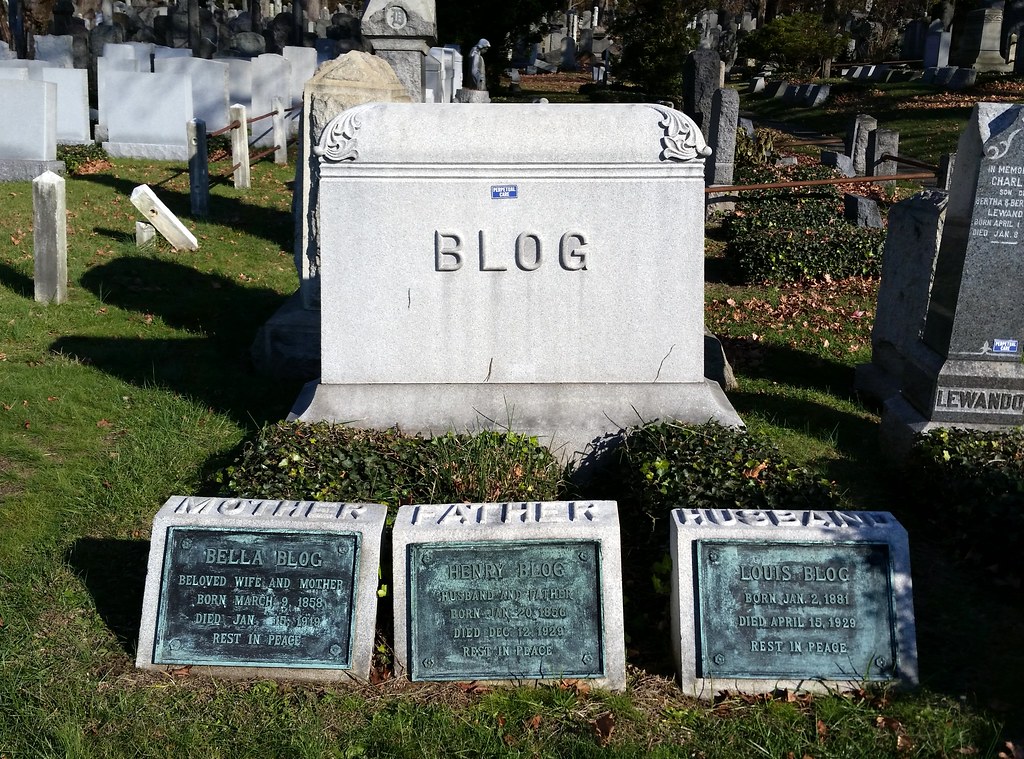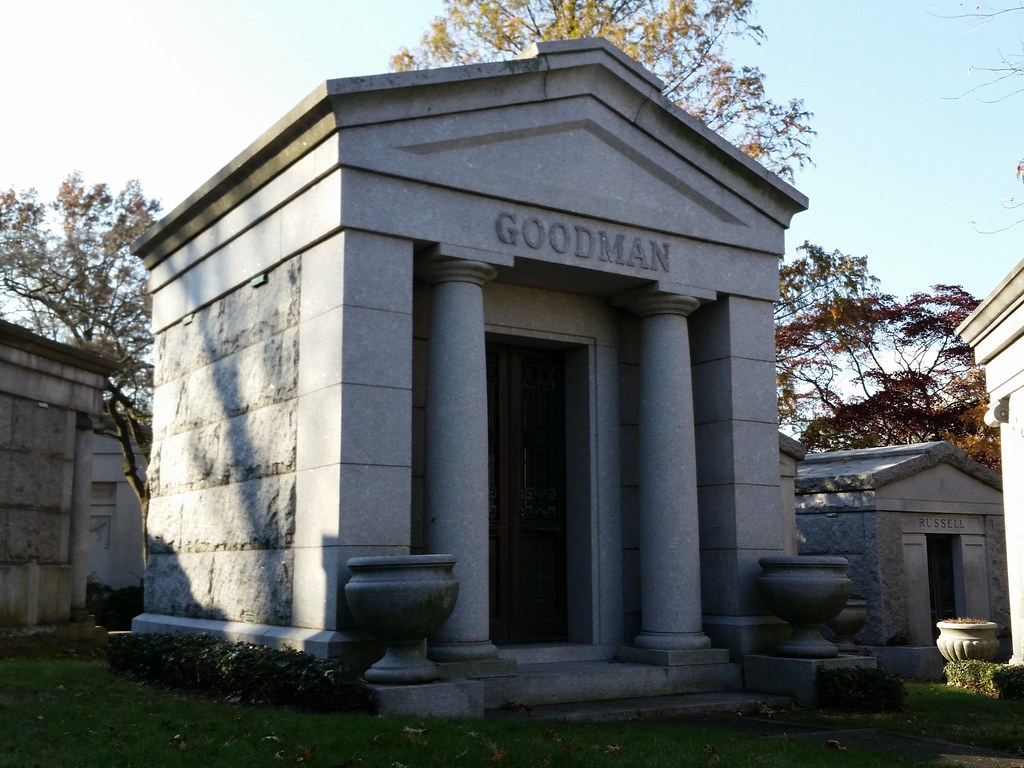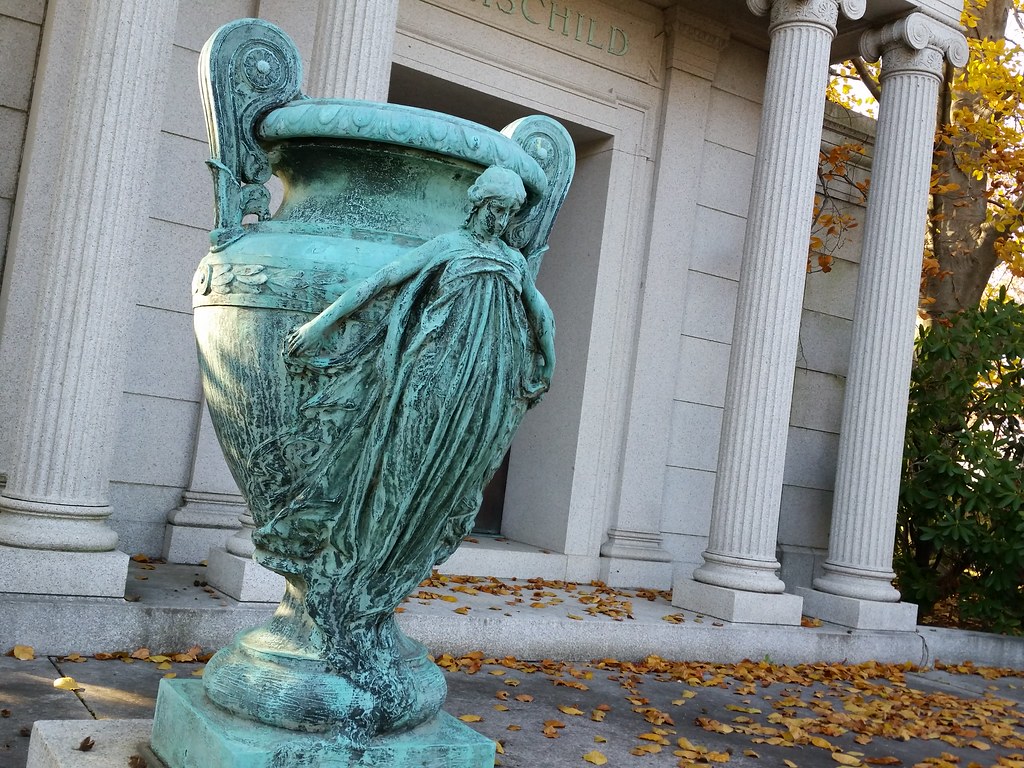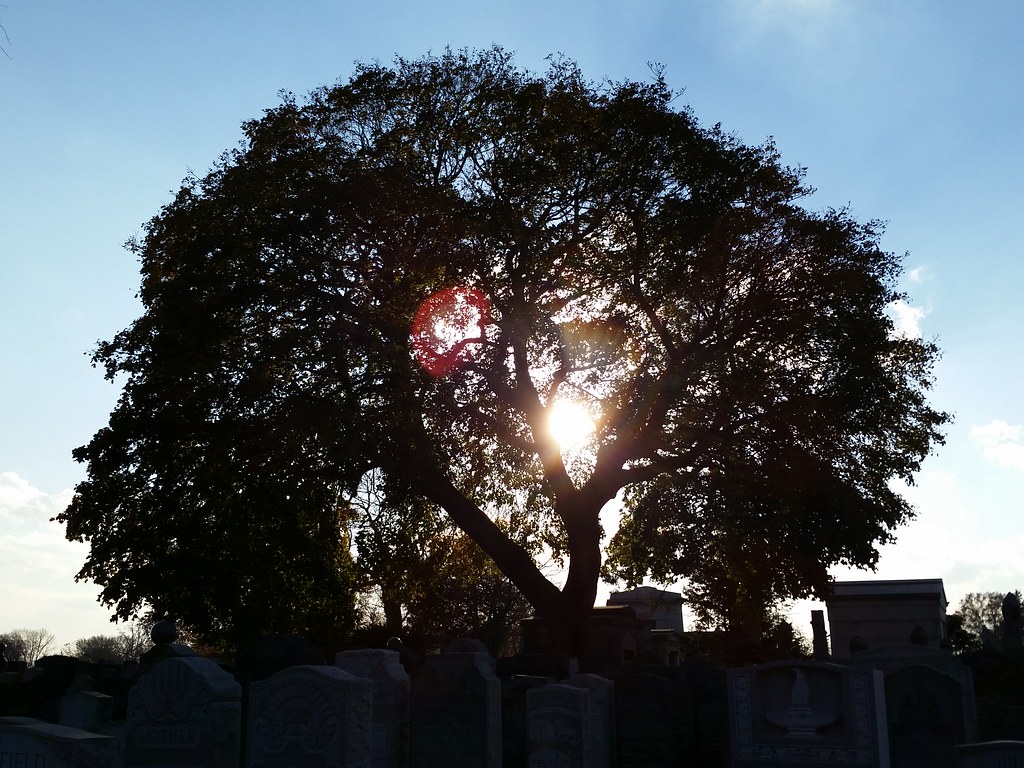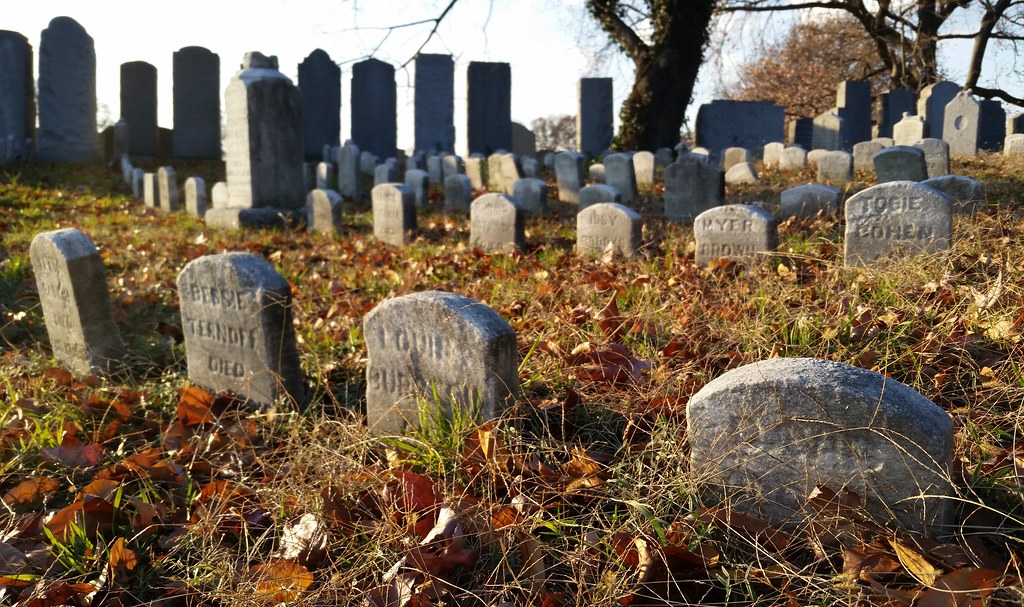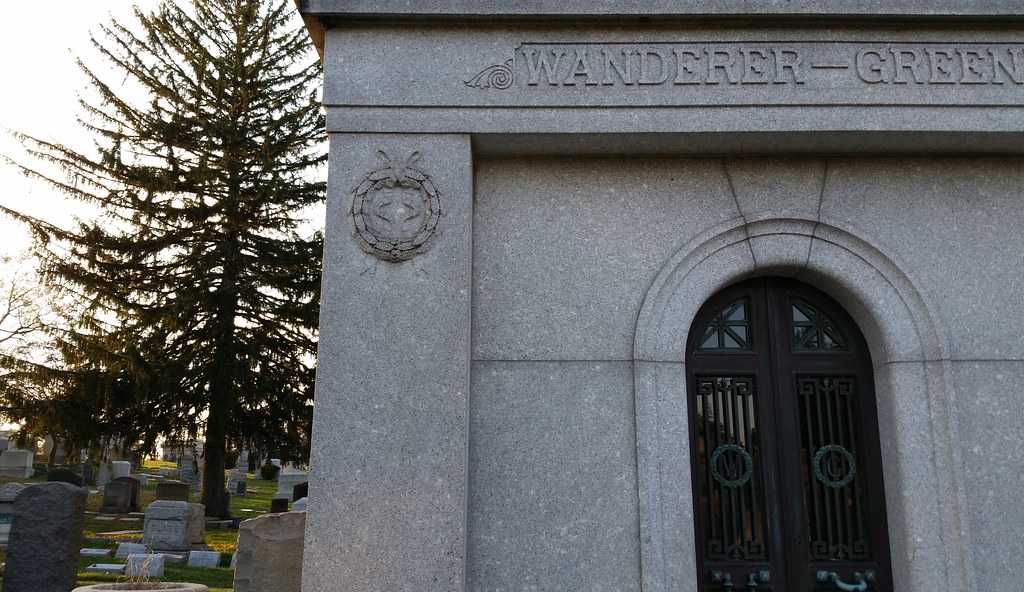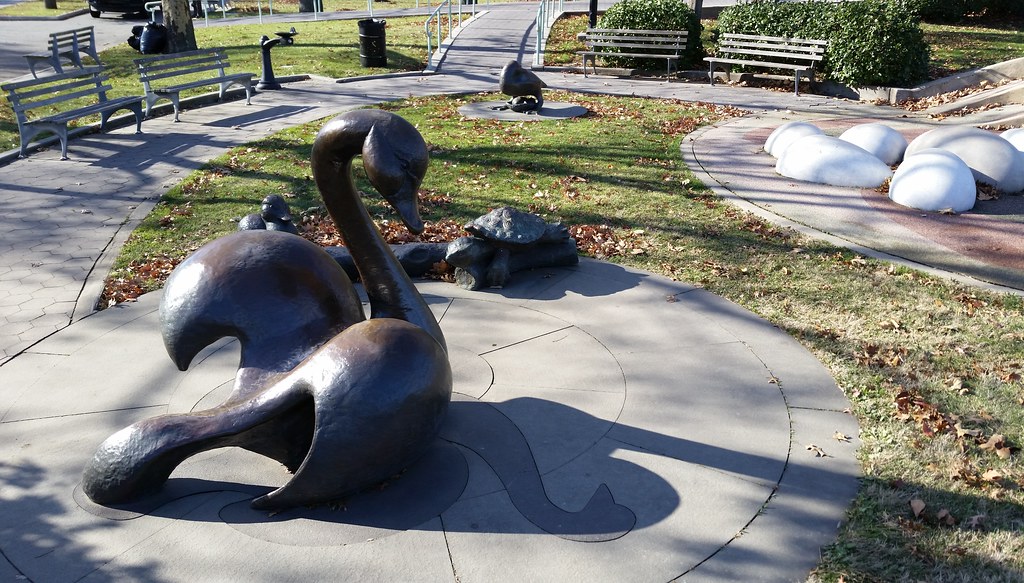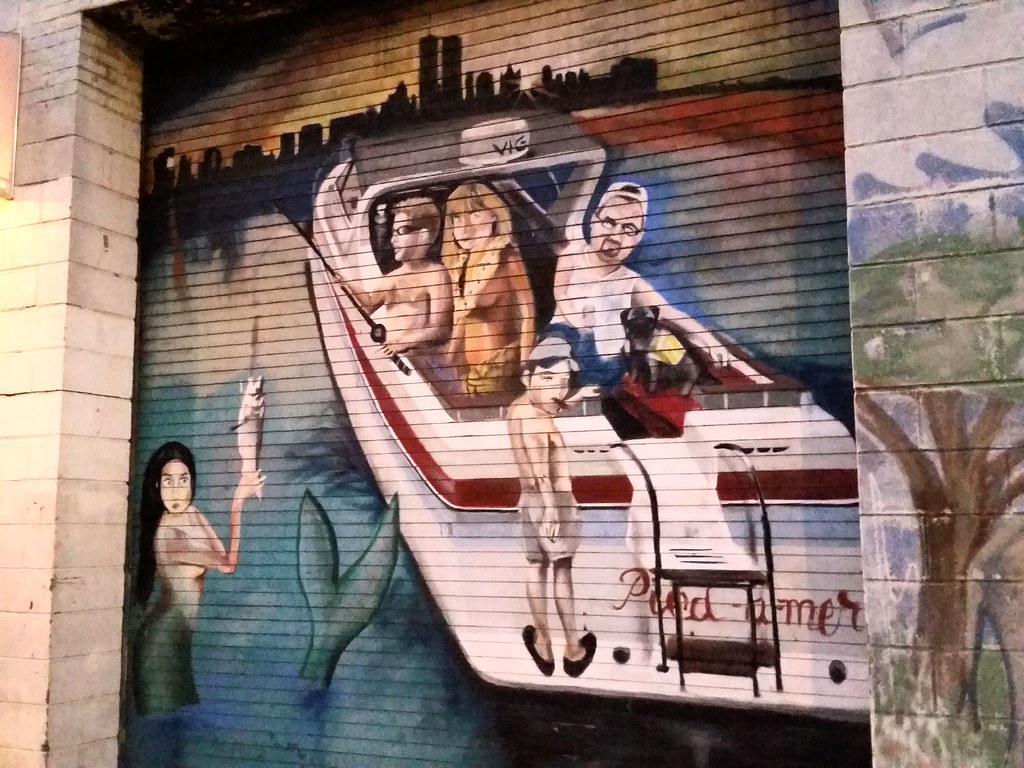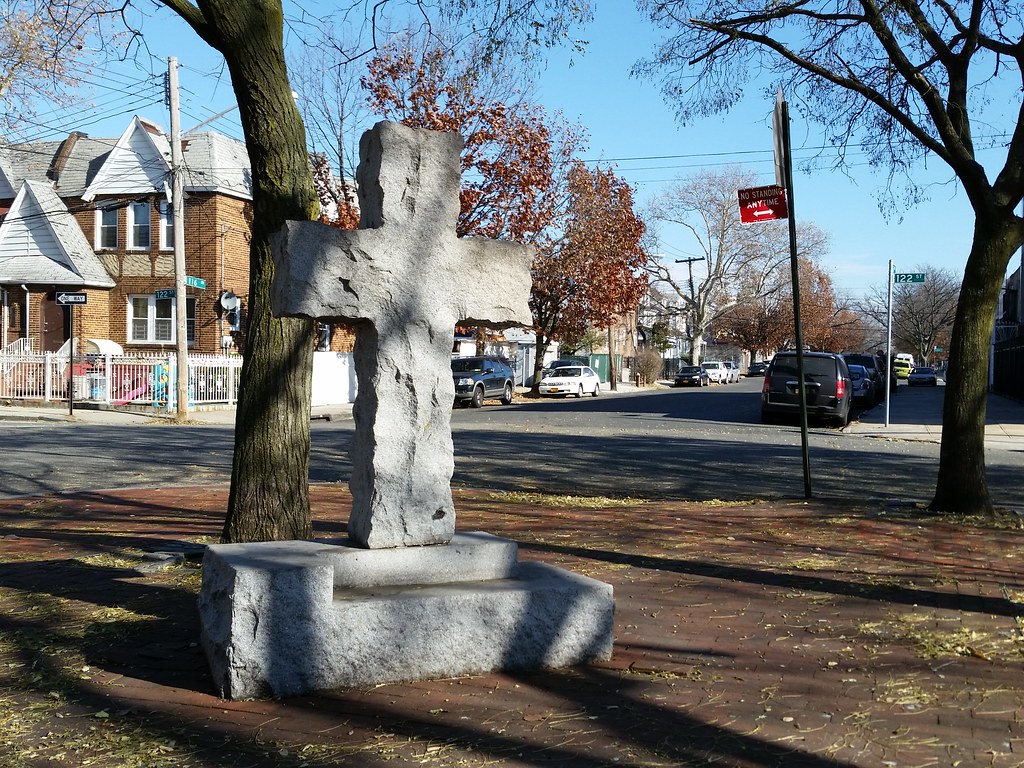
We've now moved on to Machpelah Cemetery (where, coincidentally, Joseph Banzer of Banzer's Cypress Hills Park was for years the superintendent). The "daunting, abandoned building that was once the cemetery office", seen in this video, was demolished in August 2013.
Harry Houdini, the legendary illusionist and escape artist, was buried here in 1926 following his death at the age of 52 from a ruptured appendix that may or (more likely) may not have been caused by a young man punching him in his stomach to test his abdominal strength. While Jewish custom dictates that the dead be interred in plain wooden coffins, Houdini was reportedly laid to rest in a metal-and-glass casket he had specially ordered for use in one of his stunts. Buried with him, as a pillow for his head, was a collection of letters that his late, dearly beloved mother had sent him over the years.
In case you're wondering, the colorful circular mosaic above depicts the logo of the Society of American Magicians, which Houdini presided over from 1917 to until his death. Every year, magicians from the Society hold a "broken wand ceremony" here to commemorate his death. The ceremony used to be held on Halloween, the anniversary of Houdini's death (on the Gregorian calendar), but around 1994 Machpelah's manager decided to start closing the cemetery on Halloween in an attempt to ward off vandals. The magicians now hold the ceremony on the anniversary of Houdini's death on the lunisolar Hebrew calendar — the 23rd of Cheshvan (which was November 16th this year) — except when that date happens to coincide with Halloween.
The bust of Houdini on the pedestal above is the latest of several to grace the monument; the others were all stolen or destroyed. From 1993 on, for almost two decades, the pedestal stood empty except during the annual broken wand ceremony, when the attending magicians would show up with a portable bust. The bust above has been in place since 2011, when a trio of "Houdini commandos" from the Houdini Museum in Scranton, Pennsylvania swooped in and installed it in an (initially) unsanctioned operation.
One other grave-related note: one of the smaller gravestones in front of the monument bears the names of both Houdini and his widow Bess. However, Bess is actually buried in Gate of Heaven Cemetery, a Catholic cemetery, in Westchester County. It's not entirely clear why the plans were changed and she didn't end up here in Machpelah, but I found one article that said her sister, "upset because Bess had given up her Catholicism to marry the Jewish showman", was the one who decided to bury her in Gate of Heaven instead.
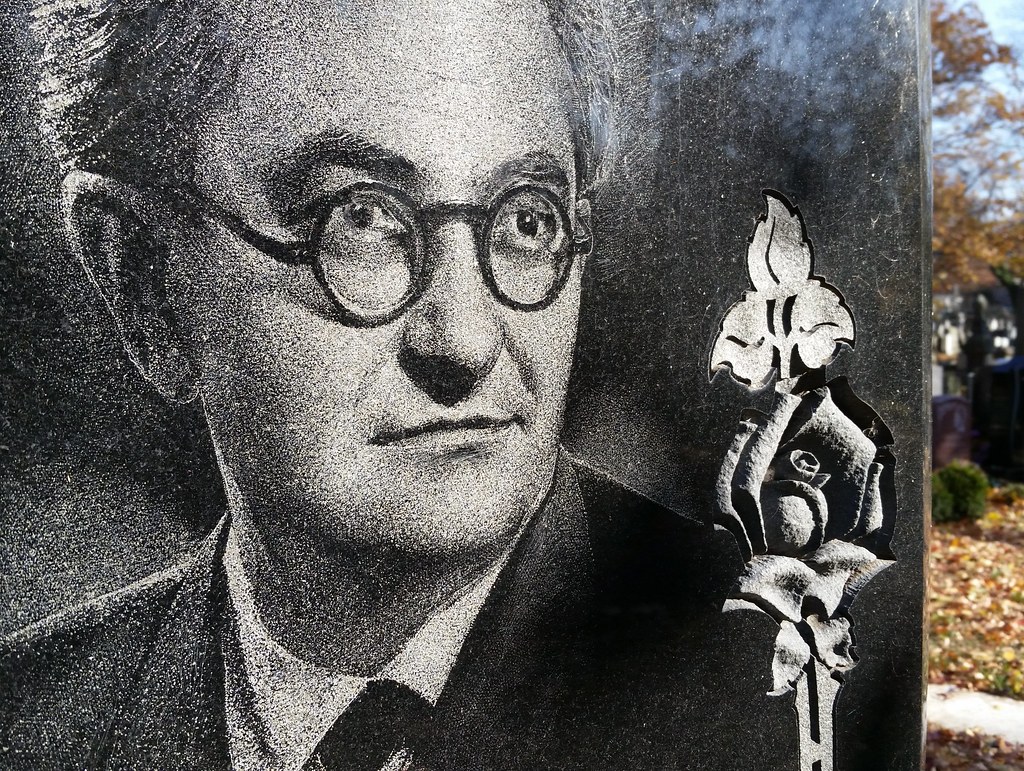
We're now in Beth-El Cemetery (apparently once known as New Union Fields Cemetery), which, like Salem Fields Cemetery, is owned by Temple Emanu-El. It previously belonged to Temple Beth-El, which merged with Emanu-El in 1927.
The headstone above stands in a section of the cemetery largely populated by the laser-etched portrait stones that, as we've seen, are in vogue among Jews from the former Soviet Union.
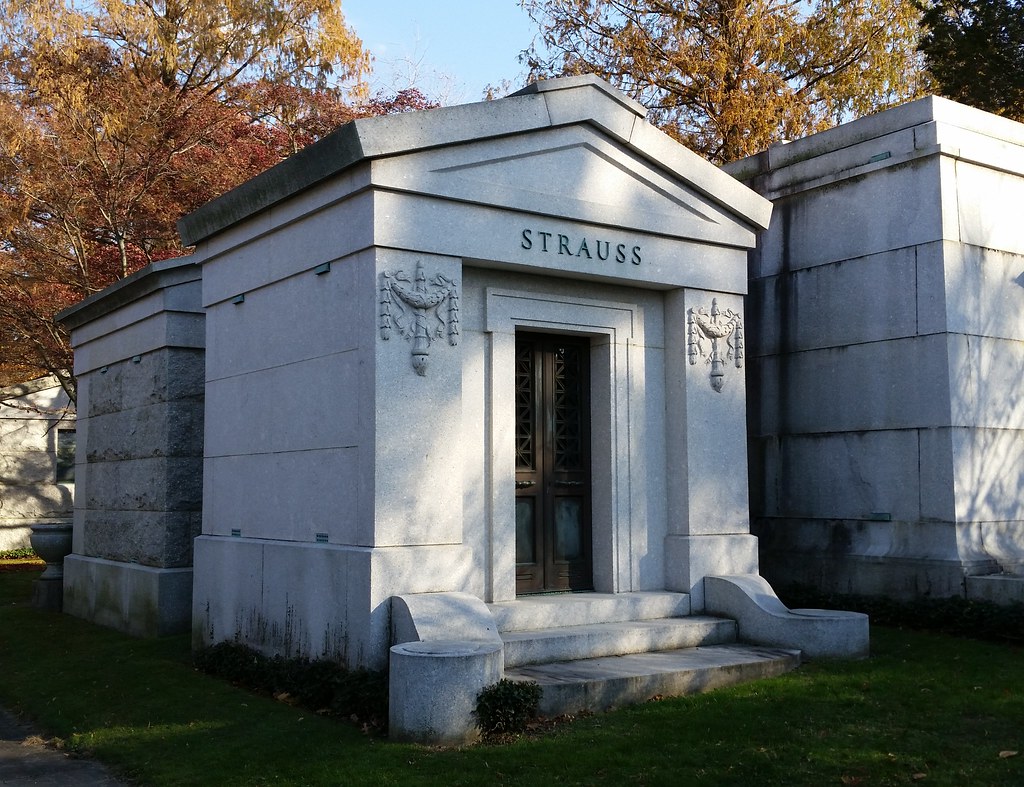
Two of the three Straus brothers, Oscar and Nathan, are buried here in Beth-El Cemetery. I was unable to find them — but I did come across this mausoleum with an extra S. As we've seen, the third brother, Isidor, is buried in an unusual tomb at Woodlawn Cemetery. He famously died aboard the Titanic with his wife Ida: he turned down a place in a lifeboat, seeing that there were still women and children on the ship, and Ida refused to leave his side.
Oscar, who served as Secretary of Commerce and Labor under President Theodore Roosevelt, was the first Jewish member of the US Cabinet. (He wasn't the first Jew to be offered a US Cabinet position, however. President Grant — who, by the way, had ordered the expulsion of all Jews from his military district during his time as a major general in the Civil War — asked Joseph Seligman to be his Secretary of the Treasury, but Seligman declined. And President Cleveland offered Oscar's brother Isidor the job of Postmaster General, then a Cabinet-level post, but Isidor turned him down as well. Oscar was also not the first Jew in America to serve in a Cabinet. That distinction belongs to Judah P. Benjamin, who held three different Confederate Cabinet positions.)
Nathan and Isidor were business partners and very successful merchants who came to own two major New York department stores: Macy's and Abraham & Straus. Nathan was also a noted philanthropist, and his signature cause was "pure milk". He suspected that many of the diseases killing large numbers of young children In the late 19th century were being contracted from contaminated raw milk. Starting in 1893, he and his wife Lina set up milk depots in the city to provide poor families with pasteurized milk at low cost. Their efforts were credited with playing a large role in the precipitous decline of the city's child mortality rate over the following 25 years, during which an estimated 240,000 children's lives were saved.

Joel Goldenberg was one of the original members of Goldenberg Brothers & Co., once one of the country's largest lace importing firms. His nephew Samuel Goldenberg, author of the illustrated Lace: Its Origin and History, was a Titanic survivor whose large canvas bag was reported by the NY Times to be the only piece of luggage saved from the ship and to have somehow never even gotten wet during the whole ordeal. Perhaps worried that people would assume he used his wealth to secure a spot on a lifeboat for his bag instead of another passenger, he wrote a letter to the Times explaining that he didn't save any of his luggage from the Titanic, but that he purchased the bag in question and all its contents once aboard the rescue ship.
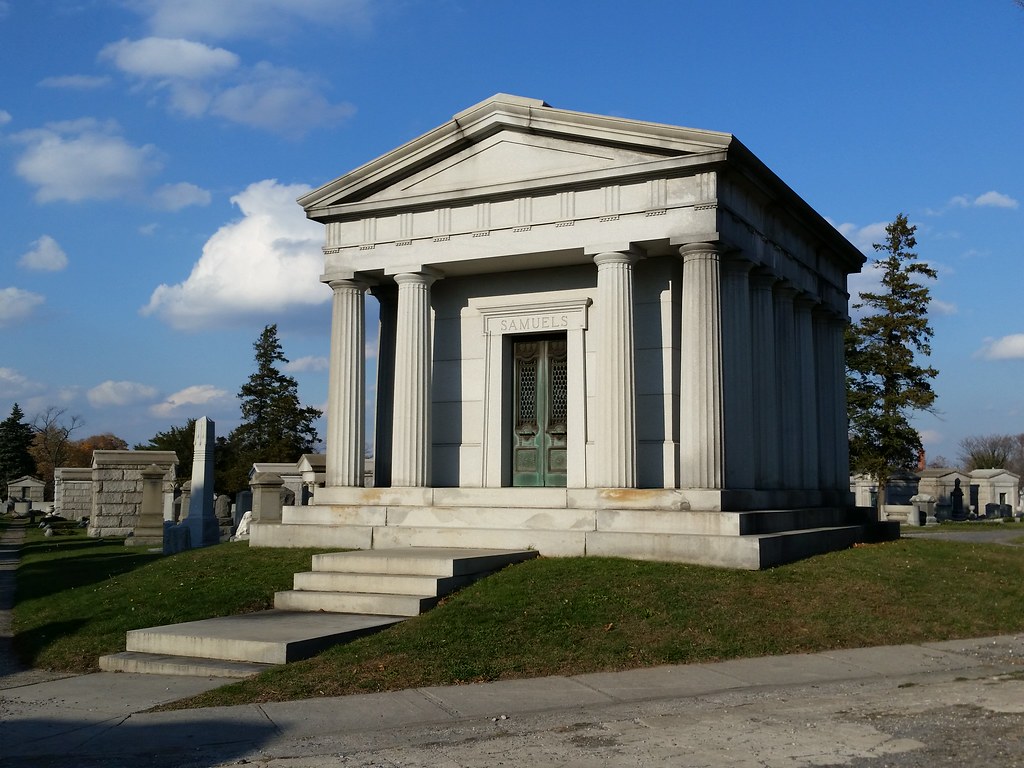
We're now in Mount Neboh Cemetery, the penultimate burial ground on today's tour through seven of the seventeen cemeteries that make up the "great verdant necropolis" spanning the middle of the Brooklyn-Queens border.

From her 1998 NY Times obituary:
Ms. Abzug represented the West Side of Manhattan for three Congressional terms in the 1970's. She brought with her a belligerent, exuberant politics that made her a national character. Often called just Bella, she was recognizable everywhere by her big hats and a voice that Norman Mailer said "could boil the fat off a taxicab driver's neck."(We're now in Old Mount Carmel Cemetery, our final cemetery of the day.)
She opposed the Vietnam War, championed what was then called women's liberation and was one of the first to call for the impeachment of President Richard M. Nixon. Long after it ceased to be fashionable, she called her politics radical. . . .
"There are those who say I'm impatient, impetuous, uppity, rude, profane, brash and overbearing. Whether I'm any of these things or all of them, you can decide for yourself. But whatever I am -- and this ought to be made very clear at the outset -- I am a very serious woman."

Sholem Aleichem, the beloved Yiddish author known as "the Jewish Mark Twain", died on May 13*, 1916. The NY Times estimated that 100,000 people lined the sidewalks of Manhattan's East Side to watch his funeral procession. He was initially buried in neighboring Mount Neboh Cemetery and was later moved to this plot in Old Mount Carmel.
* His date of death is somewhat ironic because, according to his daughter, he had a superstitious aversion to the number 13. She recalled that he "never marks a page [in his manuscripts] with the number 13—it is always 12a." It's been said — even in the NY Times — that his headstone lists his date of death as May 12a, but that is untrue. The dates given on the stone for his birth and death are from the Hebrew calendar.

Saul Yanofsky (or Yanovsky, as his name seems to be spelled everywhere except his tombstone) was apparently "one of the most renowned Jewish anarchists of the day in New York" during the late 1800s and early 1900s. His epitaph reads:
His life was ardently and unselfishly devoted toward establishing human society on principles of no coercion and no exploitation.

In 1913, 13-year-old Mary Phagan from Marietta, Georgia, was murdered at the pencil factory in Atlanta where she worked. The manager of the factory, a Jew from New York named Leo Frank, was put on trial, convicted, and sentenced to death, although it's now generally believed he was innocent. The case and its coverage in the press stoked anti-Semitic sentiment in the area, and when the governor of Georgia commuted Frank's sentence to life in prison in 1915, a mob organized by prominent citizens of Marietta abducted Frank from prison, brought him back to Marietta, and hanged him from a tree. His trial led to the founding of the Anti-Defamation League in 1913 and his lynching helped spark the rebirth of the Ku Klux Klan in 1915.
(The stone above was placed near the entrance of Old Mount Carmel Cemetery, but Frank's grave is located elsewhere in the cemetery.)
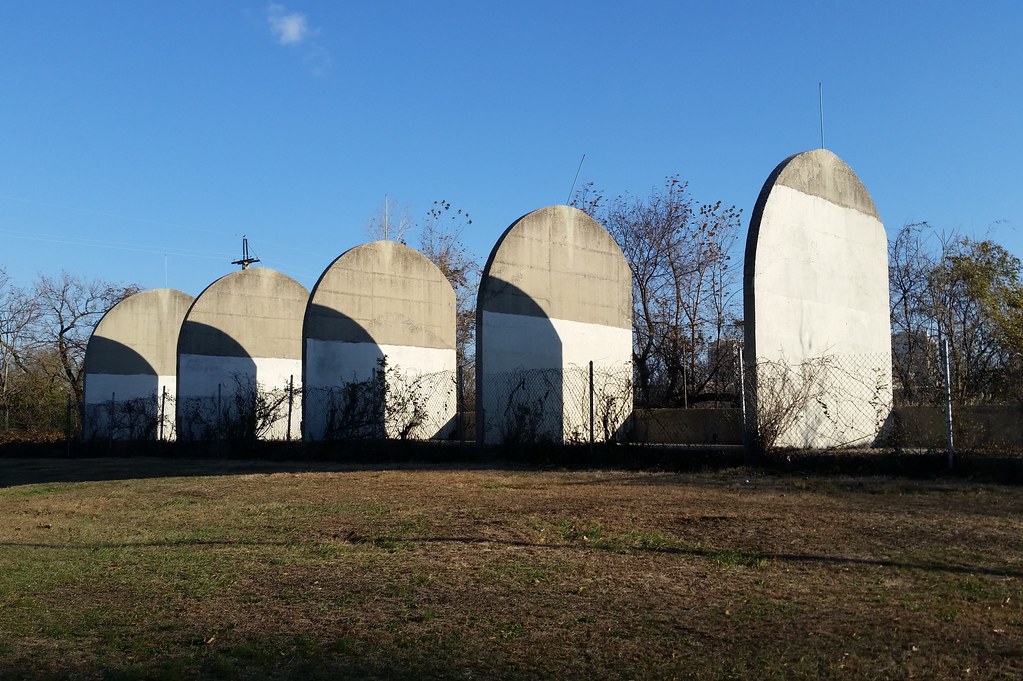
This is what remains of an electrical substation from the 1964-65 World's Fair here in Flushing Meadows-Corona Park. Similar-looking remnants of another substation from the fair, incorporated into what appears to be a newer substation, can be found farther west in the park.
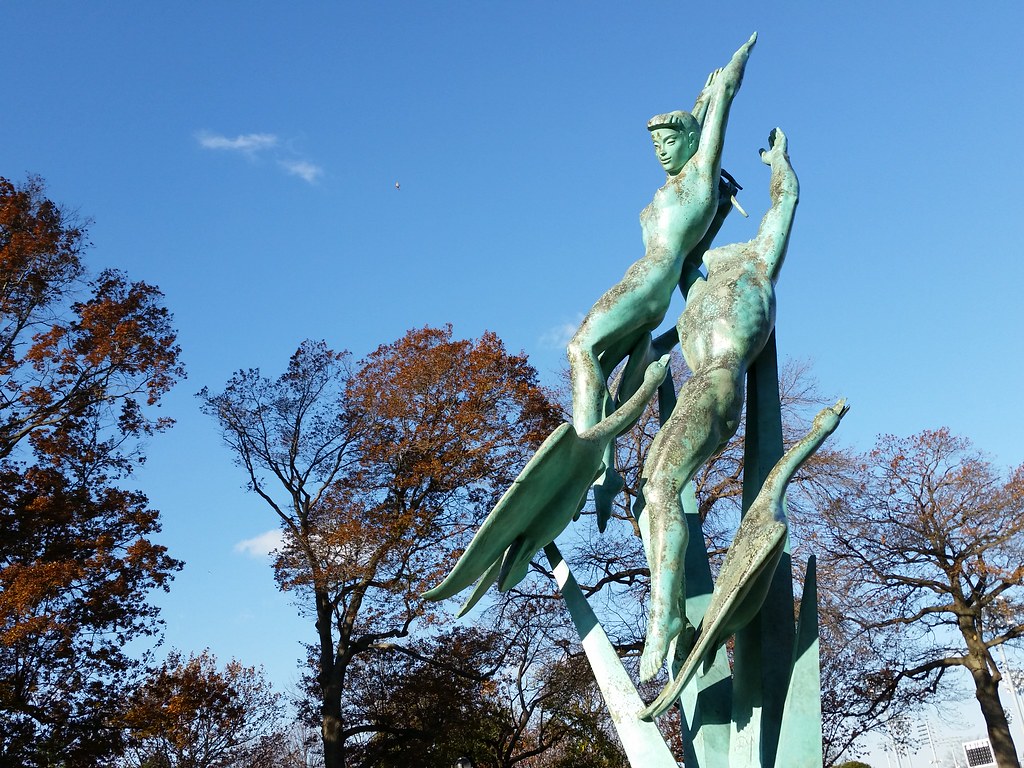
This sculpture, "depicting a male and a female nude with wild swans soaring skyward", was created for the 1964-65 World's Fair.

Located in Flushing Meadows, the USTA Billie Jean King National Tennis Center is the home of the US Open. Arthur Ashe Stadium, visible through the gate, is the largest tennis-only stadium in the world.
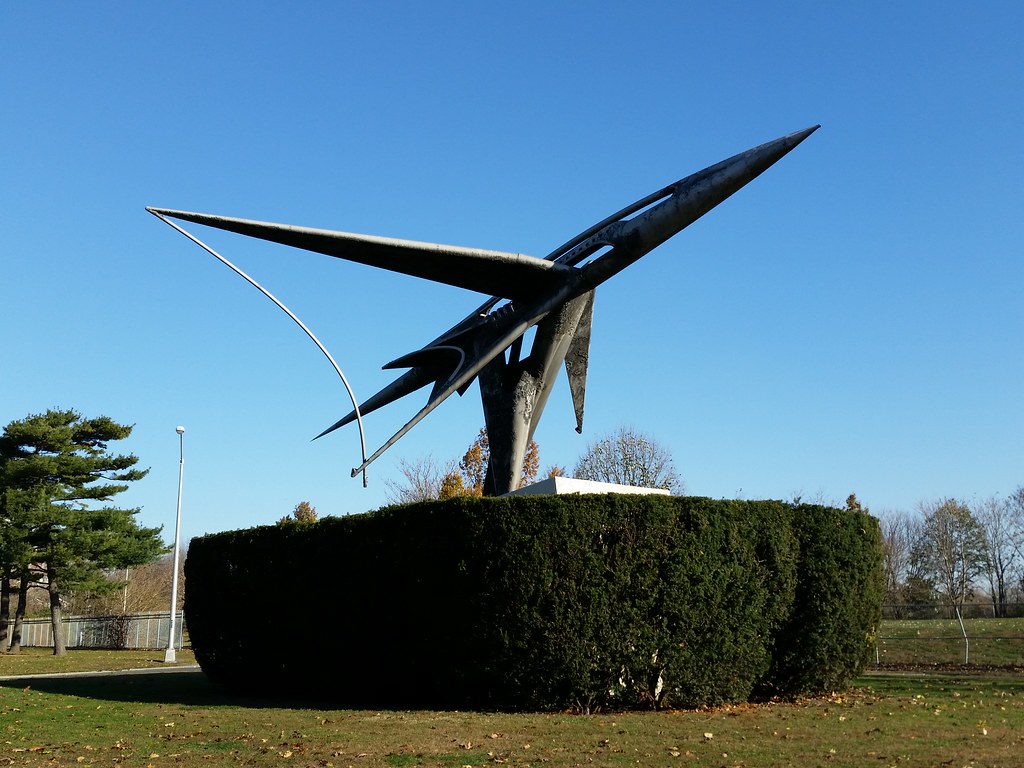
This sculpture, commissioned for the 1964-65 World's Fair, "suggests an aircraft, with fuselage and wings, but it is also meant to embody the concept of motion and change. . . . Though environmental corrosion is evident, some of the patchy, blistered surface of the sculpture appears to be original to the piece, and intended to suggest the incendiary voyage of the vessel as it passes at rapid speed through the atmosphere."

These plants outside the Queens Museum are encased in ice, although there was no precipitation last night. Could this be the result of an overzealous sprinkler system operating in just-below-freezing weather?

The Garden of Meditation is another relic of the 1964-65 World's Fair in Flushing Meadows. Today it's just a modest green space with a walking path, but it used to contain a little pond as well. The large plaque above, featuring a quotation from Francis Bacon's "Of Gardens", is joined by a few smaller stones (two identical sets of three different stones) engraved with references to Bible verses: Numbers 6, verses 24-26 (the priestly blessing, which inspired Mr. Spock's Vulcan salute); Micah 6, verse 8; and Romans 12, verses 10 and 12.
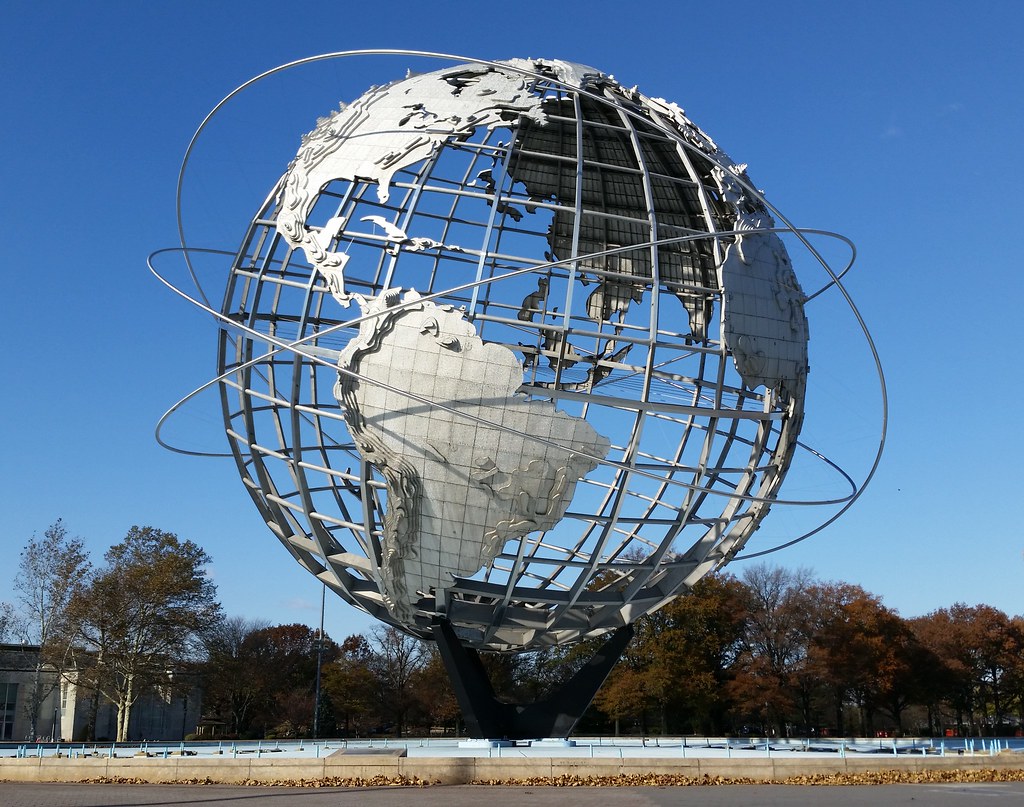
The Unisphere, which we've already seen a few times, was the centerpiece of the 1964-65 World's Fair here at Flushing Meadows. A nearby plaque reads:
UNISPHERE
Dedicated to man's aspirations toward Peace through mutual understanding
and symbolizing his achievements in an expanding universe
Built and Presented by
United States Steel Corporation
to the 1964-65 New York World's Fair, April 22, 1964
Made of Stainless Steel, the Unisphere is 140' high, 120' in diameter and weighs 700,000 pounds

This column, dating back to 120 AD, was originally part of the Roman Temple of Artemis* in the ancient city of Gerasa (today's Jerash, Jordan), and it was given to NYC by Jordan's King Hussein to commemorate his country's participation in the 1964-65 World's Fair. Standing next to the column during the fair was the Jordanian pavilion, notable for its undulating architecture, its exhibition of a Dead Sea Scroll, and its controversial anti-Israel mural. (Speaking of the 1964-65 World's Fair, that's the Unisphere in the background of this shot.) As far as I know, there's only one man-made outdoor object in the city that predates this column: the much older Cleopatra's Needle in Central Park.
* According to the inscription on a nearby stone tablet, the columns of the temple are known, intriguingly, as the Whispering Columns of Jerash. As cool as that name sounds, however, I can't find a convincing account of what it means, or even any convincing evidence that it's actually a common name for the columns. (Most mentions of it on the web have to do with this column in Flushing Meadows rather than the remaining ones in Jordan, raising the interesting possibility that the aforementioned tablet itself might be the source of the name.)
The most popular explanation for the name — found, among other places, on a New York Public Library blog — is that it refers to the whispering gallery effect created by the geometry of the temple, but that sounds suspicious to me. I don't understand how an open area of columns in a rectangular temple could form a whispering gallery. There is, however, an amphitheater in Jerash with this acoustical property. I wonder if the temple and the amphitheater have simply become conflated over time, at least in the mind of the person who wrote the text for the tablet here in the park.
Another possibility is that "whispering" describes "the sounds of the wind rustling among" the columns. The columns apparently sway a bit in the wind — which this blog post refers to as whispering — so perhaps this explanation holds some water. Or maybe it's all baloney. Who knows?
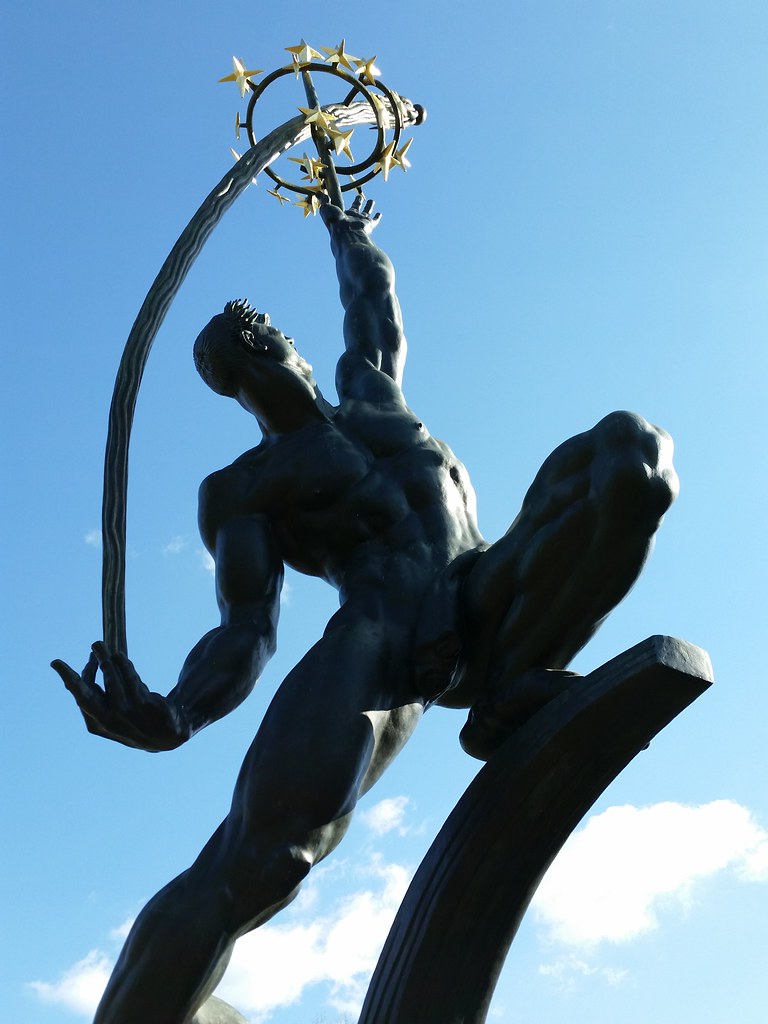
Standing 43 feet tall, this recently restored sculpture from the 1964-65 World's Fair is one of the largest works of art in the city's parks. While it may be a hit with your average parkgoing ignoramus (like me), it's not exactly beloved in the art world. A few days after the fair opened, the NY Times's sharp-tongued art critic John Canaday wrote:
And the most lamentable monster [of all the fair's artworks], making Walt Disney look like Leonardo da Vinci, is Donald [De] Lue's "The Rocket Thrower," a bronze muscle man rising 45 ridiculous feet into the air on the main axis.Ouch!
Since "The Rocket Thrower" is an absurdity that might be a satire of the kind of sculpture already discredited at the time of the 1939 fair, we might get it out of the way first by describing it as warmed‐over pseudo‐Carl Milles and left‐over semi‐Lee [Lawrie]. But to get it out of the way physically is going to be impossible, since it was commissioned as a permanent disfigurement to Flushing Meadow Park, one of the fair's residual contributions to culture.
If the jealous heavens do not level "The Rocket Thrower" with a bolt of lightning, a solution would be for some public-spirited citizen to pay for melting it down and putting it back in place. Whatever the shape of the resultant lump, it would be better than the shape the thing is in now.
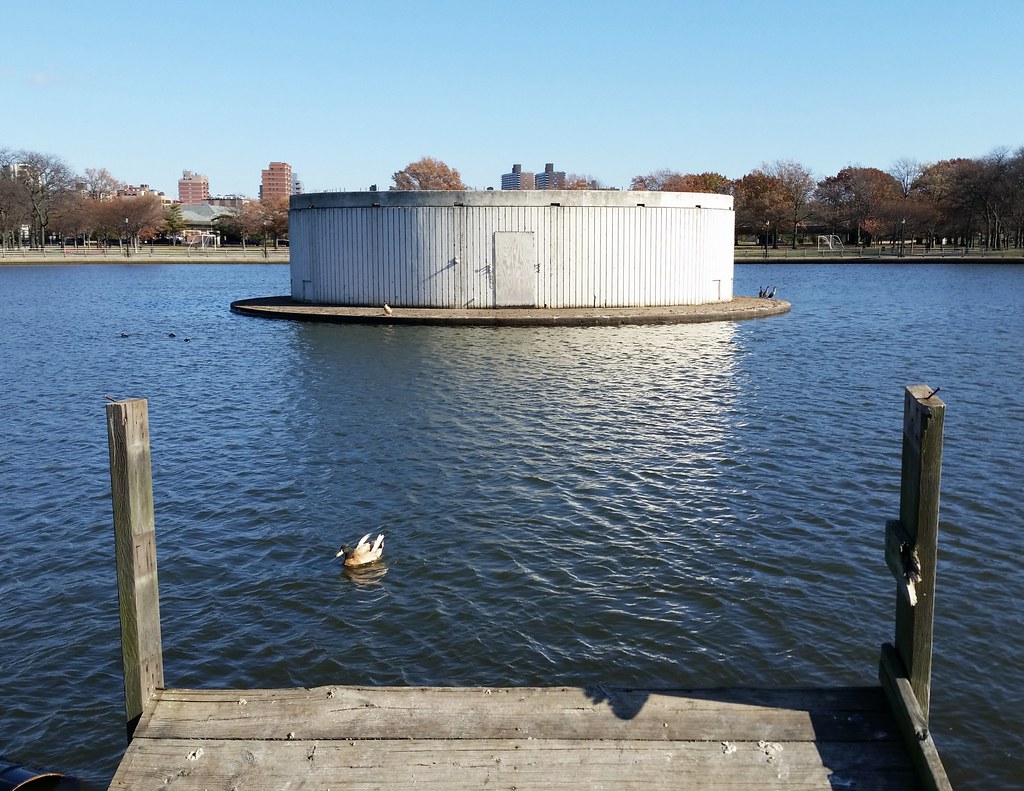
During the 1939-40 World's Fair here in Flushing Meadows, this was the site of the Lagoon of Nations, which was basically an enclosed pool built on the Flushing River (aerial views from 1938 and 1940). The lagoon contained a massive fountain and featured a spectacular nightly show of water, flames, fireworks, light, and music (video) that was described by the president of the fair as "a Niagara plus a Vesuvius". For the 1964-65 World's Fair, the adjacent sections of the river were buried to create more exhibition space, and what had been the Lagoon of Nations was expanded into the Pool of Industry. The round structure inside the pool, above, was part of the Fountain of the Planets, which was billed as the world's largest fountain. Like its predecessor from the 1939-40 fair, the fountain put on a dazzling show each night, its towering jets of water reaching as high as 150 feet.
Sometime around the early 1990s, during his reign as parks commissioner, the eternally wacky Henry Stern decided to change the name of the defunct Fountain of the Planets to "Fountain of the Planet of the Apes". About a year later, someone — this guy claims it was him — complained about the name change to the Queens borough president, and the original name was restored. Mr. Stern then turned his sights on two smaller pools in the park. He named one of them "Fountain of the Planet of the Apes" (photo) and the other "Fountain of the Grapes of Wrath" (long mislabeled on some official park maps as the even zanier "Fountain of the Planet of the Grapes of Wrath", an error mentioned, weirdly enough, in this young-adult novel). According to Mr. Stern: "We thought since we were paying tribute to a motion picture with an animal title, we should pay tribute to a motion picture with a vegetable title." Sounds reasonable to me!
Over the past decade or so, the Pool of Industry — much maligned these days as a stagnant, smelly garbage receptacle (though it seemed perfectly pleasant when I walked by) — has faced a few different threats to its survival. There have been proposals made to replace it with a whitewater slalom course for the 2012 Summer Olympics (which NYC was vying to host), a football stadium for the New York Jets, and, most recently, a soccer stadium for NYC's new MLS team. Those plans are all off the table now, but a long-range Parks Department plan from 2008 that involves turning the pool into a grassy "waterfront festival site" could still be in the works, I suppose.
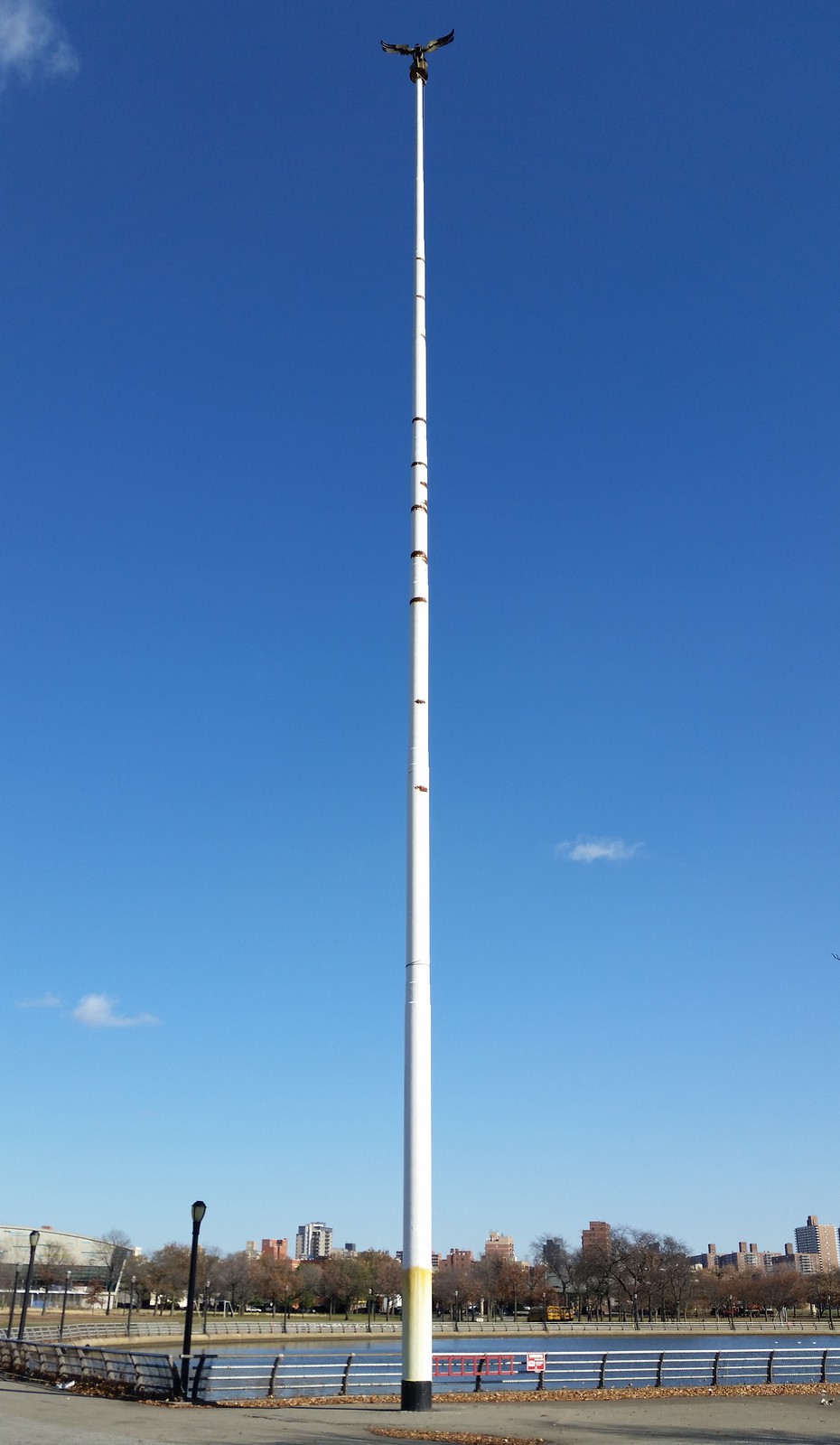
This is one of two extremely tall flagpoles, relics from the 1939-40 World's Fair, standing beside the Pool of Industry. Atop each of the poles is an Art Deco eagle finial. It's long been rumored that the poles and the eagles came from Nazi Germany, which had at one point been planning to participate in the fair but later withdrew. According to an NY Times article from 1961 about the burying of a portion of the Flushing River for the upcoming 1964-65 World's Fair (the final article on this page):
The only [nearby] sign of the last World's Fair more than twenty years ago was a pair of gigantic flagpoles . . . They were topped by eagles of the Third Reich. The swastikas had been removed.The eagles are actually American eagles sculpted for the fair by Robert Foster, however. The apocryphal story about the Nazis is probably based on the similar appearance of the eagles and the Nazi German Reichsadler, although many American eagles of that era looked pretty much the same as well.
But why are the flagpoles so tall? Another NY Times article from the lead-up to the 1964-65 fair features the recollections of 1939-40 fair officials about the battle for elevational supremacy between the US and the Soviet Union. According to the officials, the Soviets constructed a tower at their pavilion that reached 188 feet in height, higher than the US flag flying atop the US Federal Building. In response, the Americans erected these two giant flagpoles — each of them taller than the Soviet tower — by the Lagoon of Nations (the Pool of Industry's predecessor). The Soviets then added a 75-foot-tall statue of a worker to the top of their tower. (Their request to put up a statue of Joseph Stalin was denied by fair officials, so they opted instead for the worker — "a figure that many American officials later swore was Stalin in his younger days".) Including the statue's 4-foot-tall base, the Soviet pavilion reached 267 (some sources say 259) feet into the air. So the Americans added a flagpole to the top of the Parachute Jump (yes, that Parachute Jump) and hung a flag on it, 270 (other accounts say 260 to 290) feet above the ground. And for good measure, they also increased the height of the two enormous flagpoles by the lagoon.
The part of that story about the flag on the Parachute Jump is well documented, as many Americans were apparently quite upset that the illuminated red star held aloft by the statue of the Soviet worker was higher than any American flag at the fair. It wasn't until Memorial Day of 1939, a month after the fair opened, that the flag was placed atop the Parachute Jump. (The Soviet worker statue, by the way, came to acquire a few nicknames from fair employees: "Big Joe" and "Joe the Worker", perhaps because of its glorification of an average Joe and/or because of its supposed resemblance to a young Joseph Stalin, and "The Bronx Express Straphanger", presumably because it kind of looked like a commuter hanging onto a strap on a busy subway car.)
The part of the story about the flagpoles by the lagoon seems a little questionable, however. As huge as these flagpoles are, I don't think they're over 188 feet tall. (120 feet maybe? 150 at most? It's hard to say just from looking at photos; I didn't think to try to estimate when I was there in person.) They could have been reduced in height after the fair ended, of course, but even in photos from the fair, the one positioned near the Soviet pavilion looks a bit shorter than the Soviet tower, although it's hard to tell for certain because the flagpole is closer to the camera. (Here's some footage of the other pole, located on the other side of the lagoon.) One 1939 Brooklyn Daily Eagle column states that, prior to the flag being hung on the Parachute Jump, the "red star is 259 feet, but no stars and stripes are even half so far up." The column is pretty smart-alecky, though, so I don't know if I should take its claims literally.
EPILOGUE
By the time the first season of the fair ended on October 31, 1939, World War II was under way and the Soviets had invaded eastern Poland. Shortly before their invasion of Finland on November 30 (both Poland and Finland had pavilions at the fair as well, located across the Court of Peace from the Soviets), they pulled out of the fair's 1940 season. Their pavilion was taken down and shipped back to Russia; an NY Times article about the dismantling, or "grim execution", of Big Joe was headlined "SOVIET'S WORKER AT FAIR IS 'PURGED' ". (Up to that point, adding insult to injury, Joe's red star had to be kept alight every night, even after the first season of the fair ended, because the height of the Soviet pavilion made it an aviation hazard.) You can see some cool photos of the pavilion and statue being taken apart here (use the navigation controls at the top of the right-hand column to get to the fourth page).
Fair officials made "strenuous efforts" to bring in the famed (and highly exploited) Dionne quintuplets as the "prime attraction" for the 1940 season, with a plan to build an exhibition space for the girls on the site of the Soviet pavilion, but they were unable to work out a deal. The Soviets were ultimately replaced by the American Common, an outdoor space intended to be used "for patriotic pageants, festivals and other spectacles". The common contained a bandshell and open-air theater, a "Village Green", and — wouldn't you know it — a towering flagpole that "dominate[d]" the site.
For the 1964-65 fair, the giant flagpoles from the lagoon were reused. They were moved to their current positions around the Pool of Industry, which was built on the site of the lagoon. In the photos I've seen, one flew an American flag and the other flew the flag of the fair. The poles are still used to display the Stars and Stripes at times, although they were flagless today.
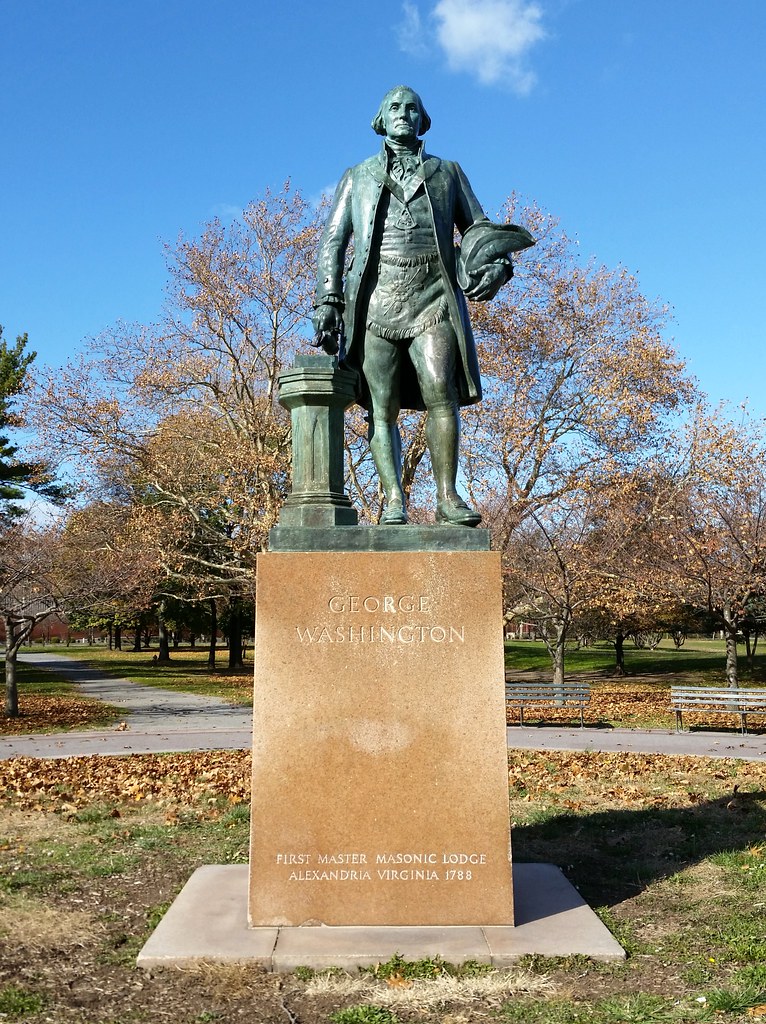
This statue of George Washington, a longtime Freemason who served as the first Master of Alexandria Lodge No. 22 in Alexandria, Virginia, is a pseudo-remnant of the 1964-65 World's Fair. The original version of the statue was created in 1959 by Donald De Lue (who also sculpted the Rocket Thrower) for the Grand Lodge of Louisiana. A plaster copy with a faux patina was put on display here in Flushing Meadows at the Masonic Brotherhood Center during the fair. This bronze replica was then commissioned for permanent display in the park and was dedicated on June 3, 1967, the date the park was handed back to the city from the World's Fair Corporation. (There are now several other copies on display around the country as well.) As part of a park renovation in 1999, cherry trees were planted around the statue; I'd imagine it's no coincidence that this playful historical allusion dates to Henry Stern's tenure as parks commissioner.
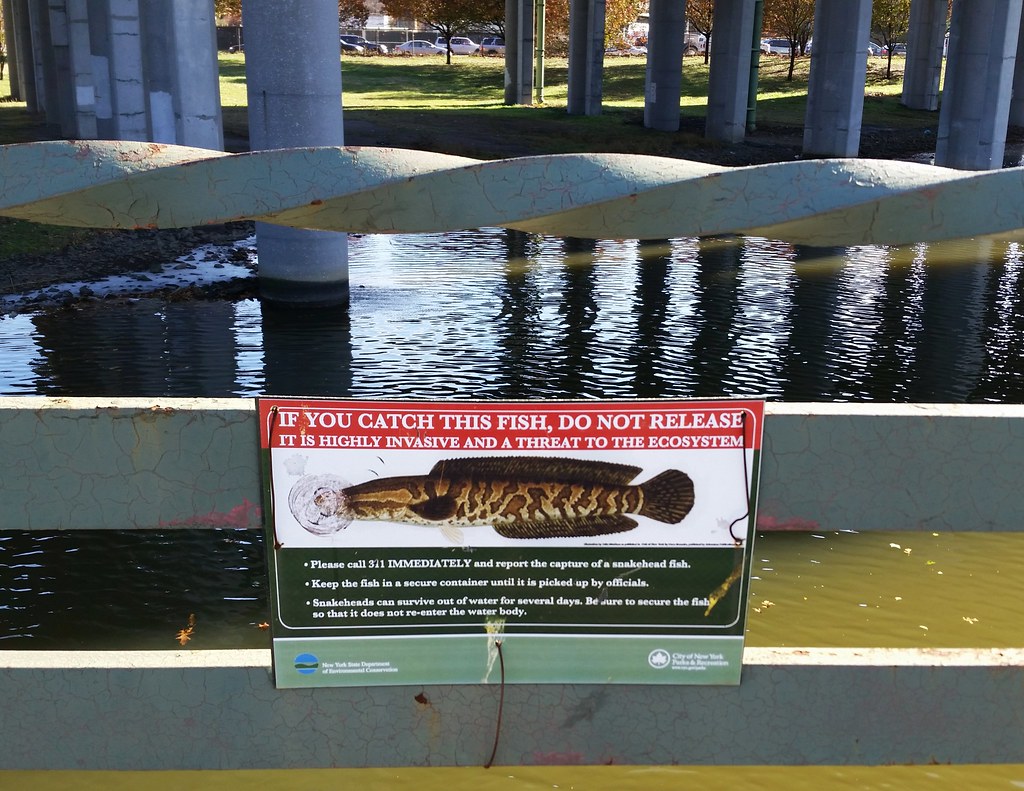
This snakehead warning sign is posted on the Flushing River downstream of Meadow Lake. The connected Meadow and Willow Lakes in Flushing Meadows are home to what is believed to be the only established population of snakeheads in the city, although a couple of the invasive fish have been spotted in Central Park's Harlem Meer as well.
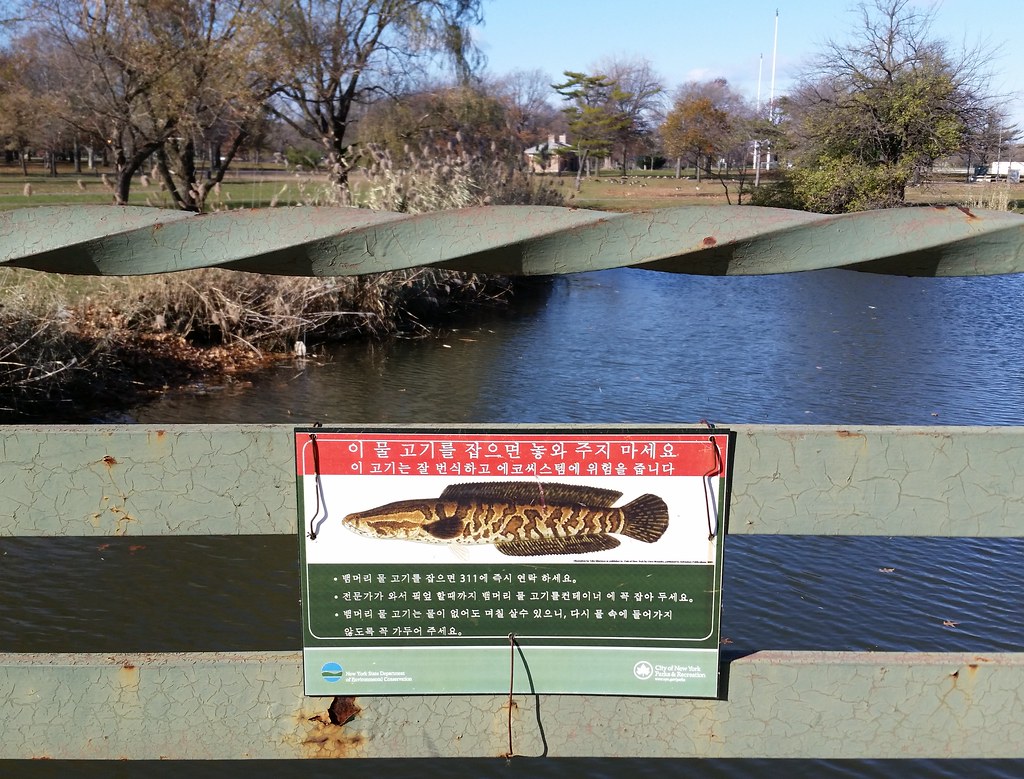
This is the Korean version of the snakehead sign. (Note the enormous twin flagpoles in the background.)
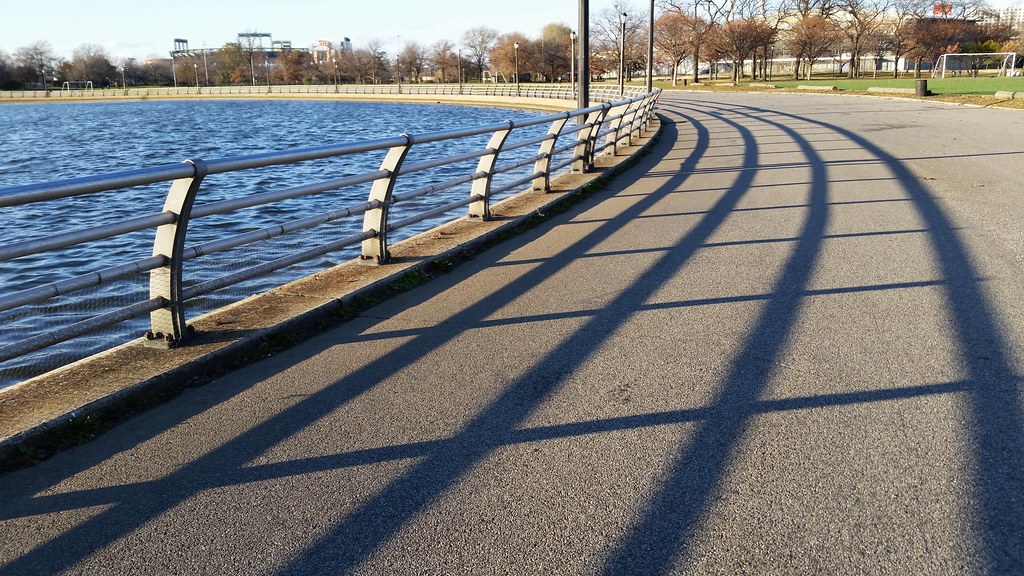
the Pool of Industry. That's the home of the Mets in the background.

From the February 29, 2008 NY Times:
In an era of private grandeur, New York City has built a temple for the public in Queens: the Flushing Meadows-Corona Park Natatorium and Ice Rink — it does not even have a corporate name — which is to open on Friday.Designed to be the water polo venue in NYC's failed bid for the 2012 Summer Olympics, this $66.3 million, 110,000-square-foot facility — with its swooping cable-stayed roof spanning an Olympic-size pool and an NHL-standard rink — was the largest and most expensive recreation building ever constructed in a city park at the time it opened (though not anymore).

Here at the Queens Botanical Garden, there's no sign explaining what this statue is or who sculpted it. A garden employee told me its identity is kind of a mystery. He said the most common belief is that it's Icarus, but I think it looks like St. Michael. (The garden employee said he'd heard that theory as well.) Zoom out and you can see where the Satan-slaying instrument in his right hand would have been. If it is indeed St. Michael, this would be the second time we've seen the archangel stripped of his weapon.
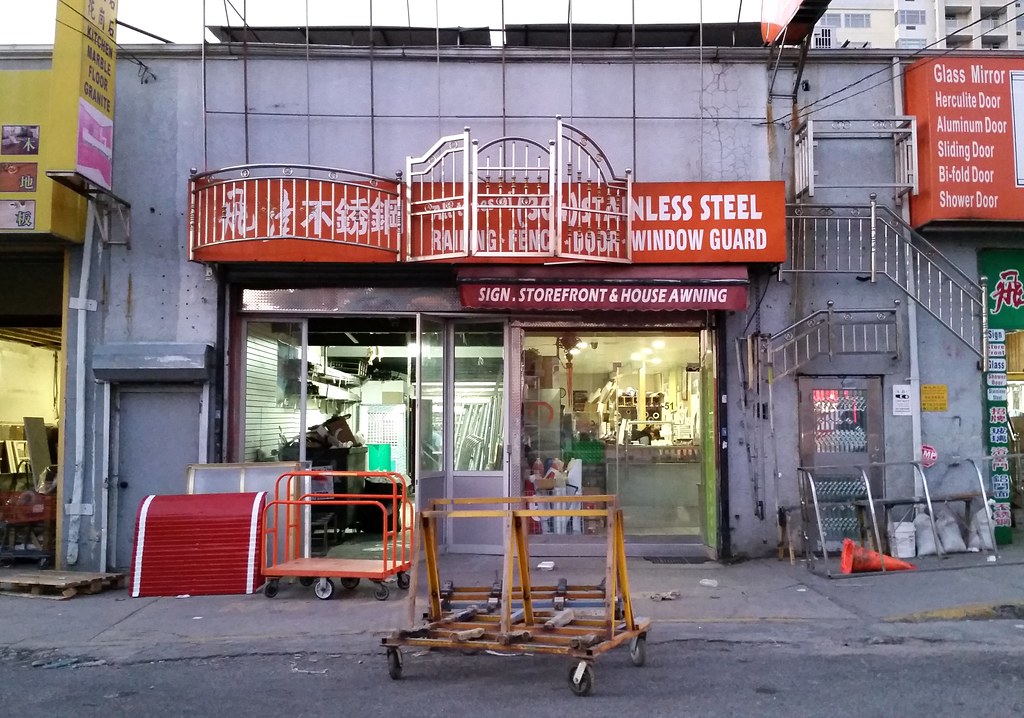
The little knot of southwestern Flushing that Kevin Walsh refers to as "The Haight" is home to at least four sellers of the ubiquitous stainless steel fencing and railing known (to some) as Queens chrome.
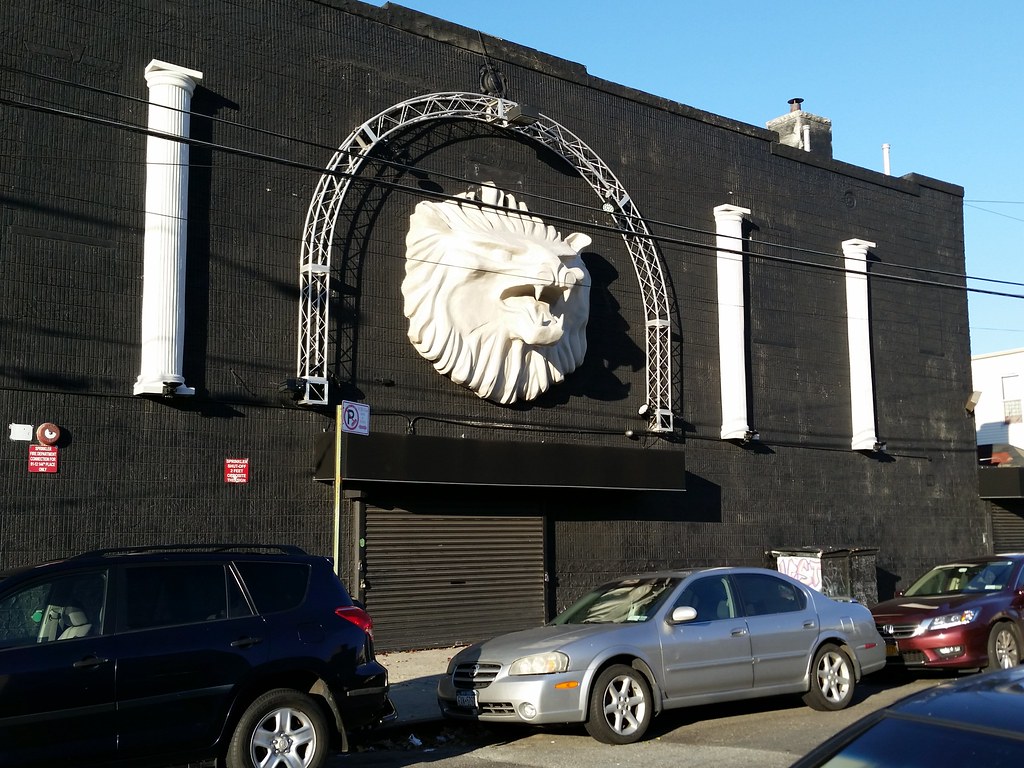
It's "for the party", a guy on the street told me.

This house seems very oddly situated today, pushed way back into the interior of the block and turned at an angle relative to its neighbors. Compare aerial images from 2012 and 1924, however, and it all starts to makes sense.
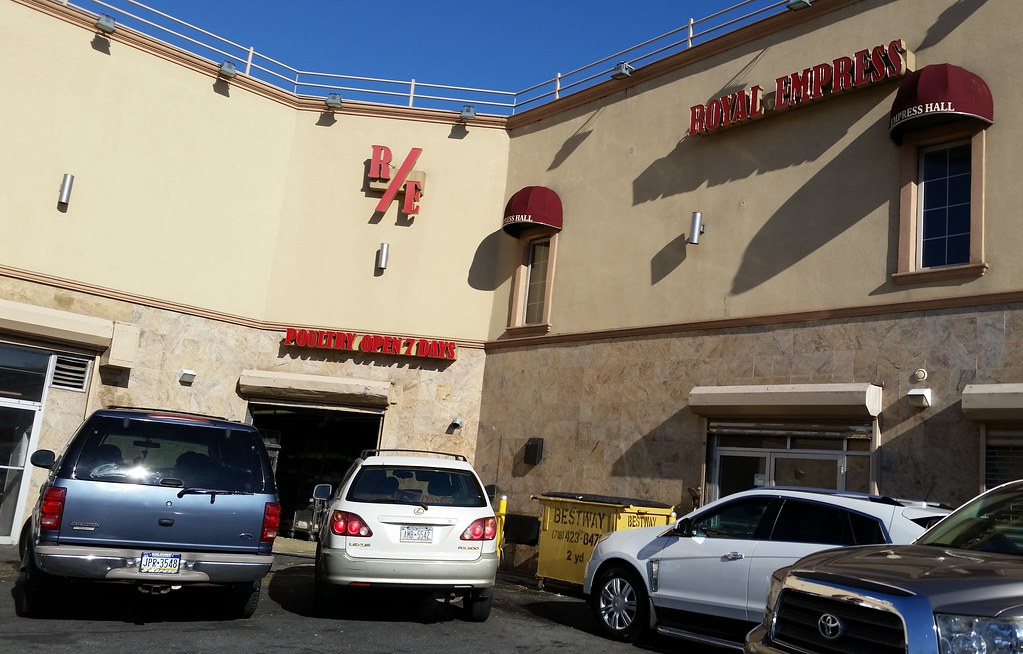
This catering hall appears to be equipped with its own poultry slaughterhouse.
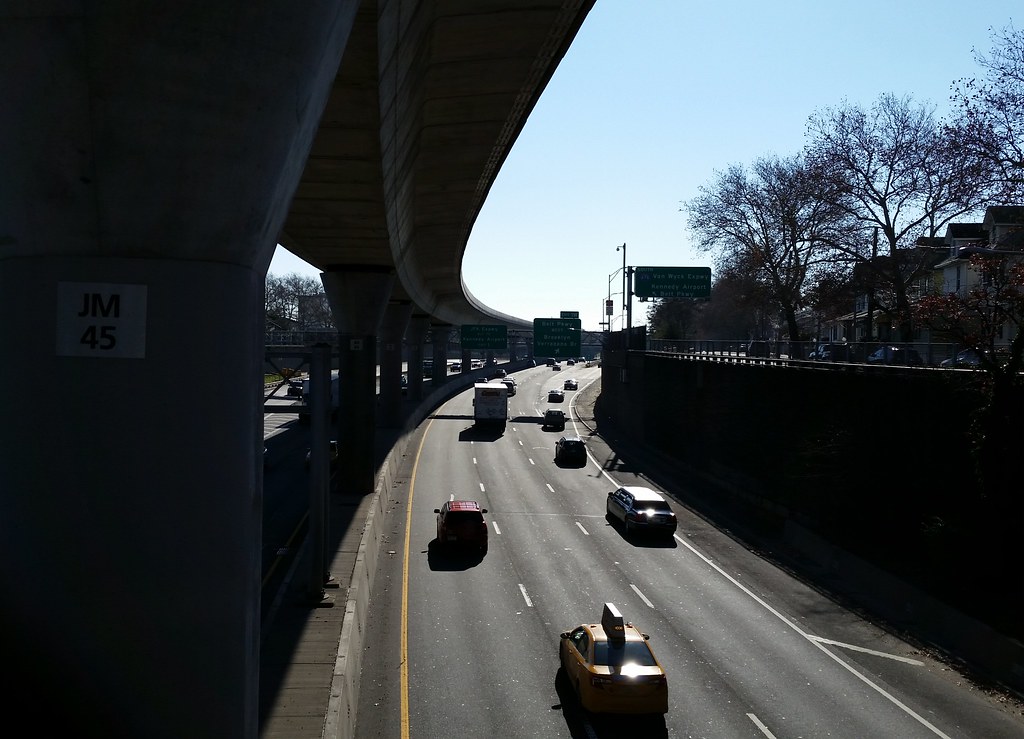
The Van Wyck Expressway and, above it, the AirTrain

What appears to have been a little-used bulletin board for the Teens At Parks program here at Baisley Pond Park has been transformed into a memorial for D'aja (Asia) Robinson, a 14-year-old girl who was killed in 2013 when the bus she was riding was fired upon and she was struck in the head by a bullet apparently intended for someone else.

